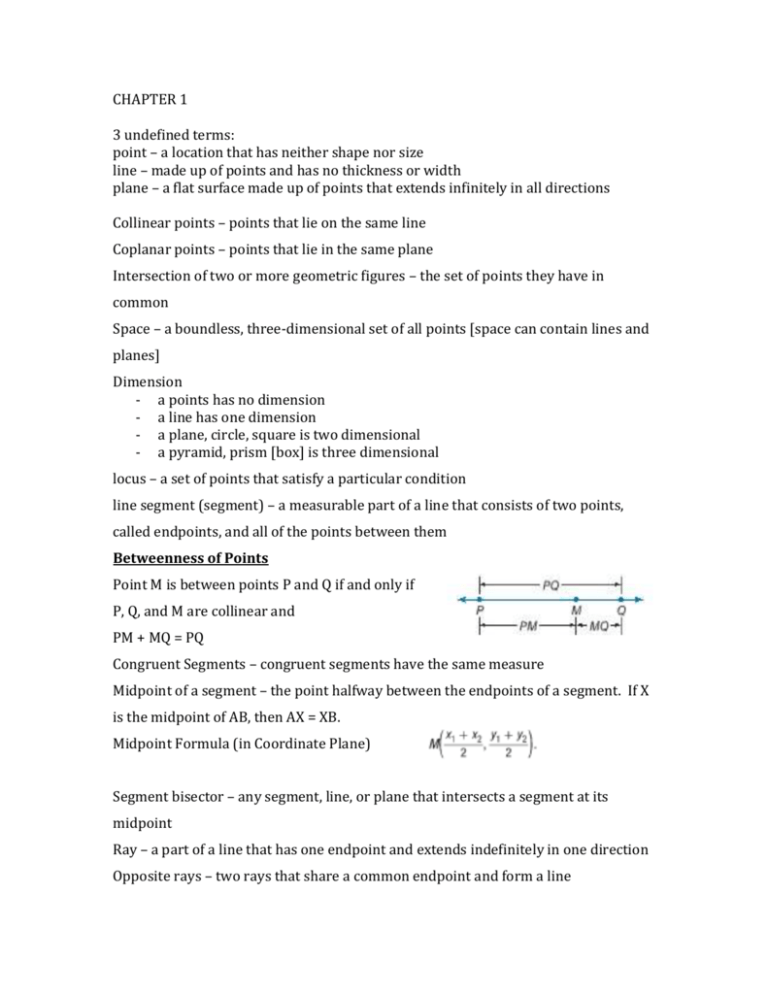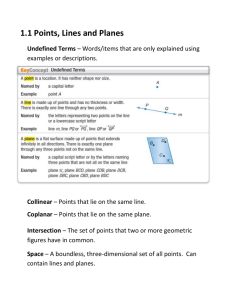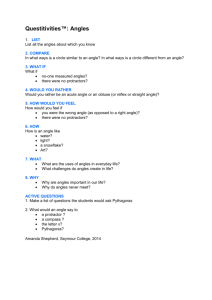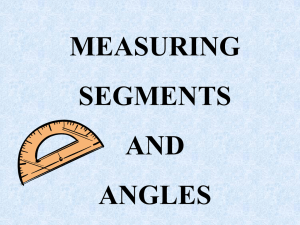CHAPTER 1 3 undefined terms: point – a location that has neither
advertisement

CHAPTER 1 3 undefined terms: point – a location that has neither shape nor size line – made up of points and has no thickness or width plane – a flat surface made up of points that extends infinitely in all directions Collinear points – points that lie on the same line Coplanar points – points that lie in the same plane Intersection of two or more geometric figures – the set of points they have in common Space – a boundless, three-dimensional set of all points [space can contain lines and planes] Dimension - a points has no dimension - a line has one dimension - a plane, circle, square is two dimensional - a pyramid, prism [box] is three dimensional locus – a set of points that satisfy a particular condition line segment (segment) – a measurable part of a line that consists of two points, called endpoints, and all of the points between them Betweenness of Points Point M is between points P and Q if and only if P, Q, and M are collinear and PM + MQ = PQ Congruent Segments – congruent segments have the same measure Midpoint of a segment – the point halfway between the endpoints of a segment. If X is the midpoint of AB, then AX = XB. Midpoint Formula (in Coordinate Plane) Segment bisector – any segment, line, or plane that intersects a segment at its midpoint Ray – a part of a line that has one endpoint and extends indefinitely in one direction Opposite rays – two rays that share a common endpoint and form a line Angle – formed by two noncollinear rays that have a common endpoint [the rays are the sides of the angle and the common endpoint is the vertex of the angle] acute angle – an angle with a measure less than 900 right angle – an angle with a measure of 900 obtuse angle – an angle with a measure greater than 900 and less than 1800 straight angle – an angle with a measure of 1800 angle bisector – a ray that divides an angle into two congruent angles adjacent angles – two angles that lie in the same plane and have a common vertex and a common side, but no common interior points [they do not overlap] linear pair – a pair of adjacent angles with noncommon sides that are opposite rays [linear pair form a straight angle] vertical angles – two nonadjacent angles formed by two intersecting lines complementary angles – two angles with measures that have a sum of 900 [an angle and its complement equal to 900] supplementary angles – two angles with measures that have a sum of 1800 [an angle and its supplement equal to 1800] perpendicular - lines, segments or rays that form a right angle CHAPTER 2 Inductive reasoning – reasoning that uses a number of specific examples to arrive at a conclusion. Conjecture – a concluding statement reached using inductive reasoning Counterexample – false example, used to prove a conjecture is false Statement – a sentence that is either true or false Compound statement – two or more statements joined by the word “and” or “or” - conjunction – compound statement using the word “and” [notation: p q ] - disjunction – compound statement using the word “or” [notation: p q ] negation – a statement that has the opposite meaning and truth value of an original statement [ notation: ~p, read “not p”] conditional statement – a statement that can be written in if-then form. Related conditionals Converse – formed by exchanging the hypothesis and conclusion of the conditional statement [notation: q p ] Inverse – formed by negating both the hypothesis and conclusion of the conditional statement [notation: ~ p ~q ] Contrapositive – formed by negating both the hypothesis and the conclusion of the converse of the conditional [notation: ~ q ~p ] Biconditional – the conjunction of a conditional and its converse Deductive reasoning – uses facts, rules, definitions, or properties to reach logical conclusions from given statements. Valid methods for proving a conjecture LAW OF DETACHMENT If p q is a true statement and p is true, then q is true LAW OF SYLLOGISM If p q and q r are true statements, then p r is a true statement Postulate or axiom – a statement that is accepted as true without proof Proof – a logical argument in which each statement you make is supported by a statement that is accepted as true Algebraic proof – a proof that is made up of a series of algebraic statements Two-column proof – contains statements and reasons organized in two columns







